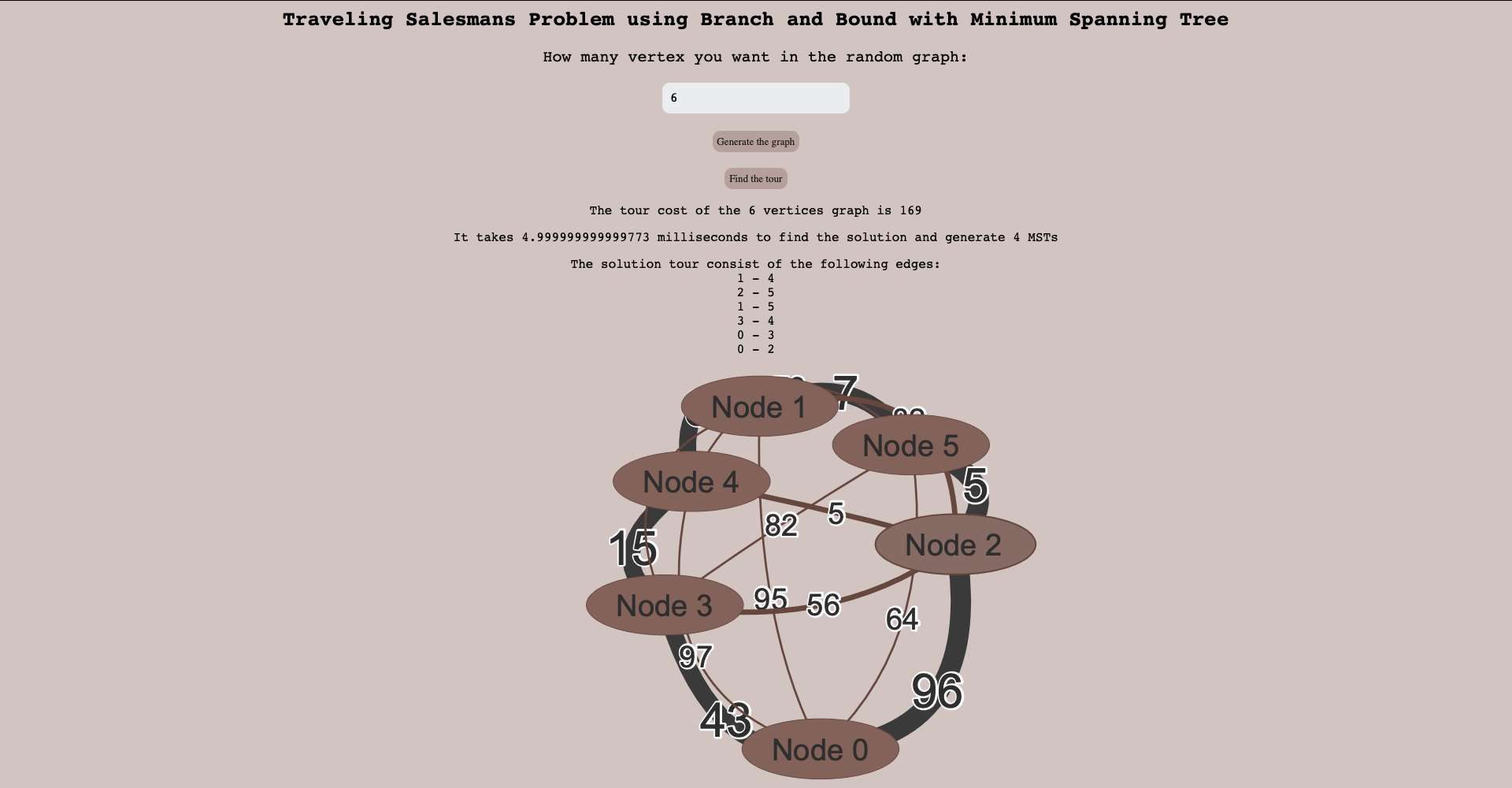Solving and visualizing the Traveling Salesman Problem using Branch and Bound algorithm with Minimum Spanning Tree
The branch and bound algorithm is based on the principle that we cut off the subset of the solution, e.g: feasible suboptimal solution, that is, the total set of feasible solutions is partitioned into smaller subset of solution. The total number of possible solutions is reduced by the branching process, and the smaller subsets can then be evaluated systematically until the best solution is found. At the heart of this bottom-up method, we'll see one of the things we keep track of is the bound. We'll keep track of what a lower bound is or, in other words, the best solution could possibly be. And the bound guarantees that we can solve each sub-problem and find the global optimal. Generally speaking, the branching strategy and the bound calculation of the node can be obtained in any way. Here, we will use the Minimum Spanning Tree algorithm to yield an undirected path that connects all the vertices together at the lowest cost and calculate the cost of the tour as lower bound, and the vertex with the highest degree is the one we branch on in the next step.
In summary, the branch and bound algorithm stepwise enumerates all the possible candidate solutions by exploring the search space by the means of a decision tree. In each node, we will branch and constraint to achieve the sub-problem in the next level, and we will calculate the bound of the following splitted node to see if the feasible solution is better than the solution we found so far to decide whether to update the best solution.
The notation of the algorithm is as followed:
-
$G = (V,E)$ the input undirected graph of TSP. -
$c : E \rightarrow R$ is the weight of the edge should be non-negative. -
$P \subseteq E$ the path P is the set of edge E. -
$MST()$ is the minimum spannign tree algorithm, and the$MST(E')$ refer to the algorithm in the subgraph$G(V,E')$ -
$C^*$ the best tour ever found.
Our goal is to find a tour that visits all vertices once, the algorithm is described in algorithm 2. While the pseudo code stated below is formulated as an iterative scheme, in our implementation it’s implemented with recursion to simplify variables in the scope.
Algorithm MST Branch and Bound for TSP
while
Take top
if
continue {Prune by infeasibility}
end if
Compute $M:=MST(E')**
if
Let
if
end if
end if
if
continute {Pruned by sub-optimality}
end if
Let
Let
push
end while
In general, the algorithm has a complexity of
I perform a simple experiment by creating the random graph and find the solution repeatedly, and the average of 4 experimental results are shown in the following tables. We notice that the execution time of the algorithm increases exponentially, and the 9 vertex graph takes forever to execute due to its exponential nature.
The execution time of Branch and Bound algorithm.
| num of vertices | the avg time (milliseconds) |
|---|---|
| 6 vertices | 9.2 |
| 7 vertices | 227 |
| 8 vertices | 142,966 |
The number of Minimum Spanning Trees in the algorithm.
| num of vertices | num of MSTs |
|---|---|
| 6 vertices | 2,798 |
| 7 vertices | 485,668 |
| 8 vertices | 60,370,229 |
After you generate the graph, you can interact with any vertex by dragging the whole graph or specific vertex, zoom in and out, and click on the vertex to highlight the vertices and edges. Once you find the tour, you can untangle the vertice and edges to check the tour as you like.
Under the project directory, follow the instructions below to setup the environment for Branch and Bound visualization
Install node.js, which includes NPM package manager for the javascript, from here
For windows operating system, download the file and follow the instruction here
For Mac user, you can either download the file and follow the instruction, or you can install it with homebrew.
brew install node
After install the node.js, you can check if the NPM is also installed successfully by
npm version
Install the package for graph processing.
npm install js-graph-algorithms
Install the package for deep cloning the graph.
npm install lodash
Once you go through the installation instructions, you can open the jsgraph_BB_TSP_Visualization.html with Safari or Chrome web browser.
Referenced library and package:
